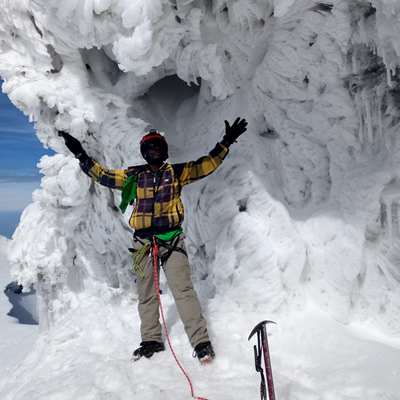Mount Baker, also known as Kiyanja, stands proudly within the Rwenzori Mountains National Park in Uganda, a mere 2.8 kilometers from the border with the Democratic Republic of the Congo. Rising to an impressive height of 4,844 meters (15,892 feet), it claims its place as the fifth highest mountain in Africa, nestled amidst the majestic peaks of the Rwenzori Range. This mountain, along with Mount Stanley and Mount Speke, forms a triangular boundary encompassing the upper Bujuku Valle which is also the centre of the mountain.
The rugged terrain of Mount Baker is characterized by multiple jagged peaks along its ridge, the highest of which is known as Edward Peak. Its challenging slopes and scenic landscape have attracted explorers and adventurers for centuries, eager to conquer its tall heights and uncover its mysteries.
 The history of Mount Baker’s exploration dates back to the early 20th century when Austrian mountaineer Rudolf Grauer, accompanied by British missionaries H. E. Maddox and H. W. Tegart, first reached the ridge line of the mountain in January 1906. Subsequent expeditions, including one led by the Duke of the Abruzzi, ventured to its summit, marking significant milestones in mountaineering history.
The history of Mount Baker’s exploration dates back to the early 20th century when Austrian mountaineer Rudolf Grauer, accompanied by British missionaries H. E. Maddox and H. W. Tegart, first reached the ridge line of the mountain in January 1906. Subsequent expeditions, including one led by the Duke of the Abruzzi, ventured to its summit, marking significant milestones in mountaineering history.
However, the roots of Mount Baker’s name delve deeper into the annals of exploration. Originally known by the Bakonjo people as “Kiyanja,” its distinctive features captured the attention of European explorers. During an expedition in June 1891, Franz Stuhlmann observed the peak and christened it either “Semper” or “Ngemwimbi.” It was later renamed by the Duke of the Abruzzi in honor of Samuel Baker, a renowned British explorer of the 19th century. Baker’s pioneering journey led him to the discovery of Lake Albert, situated northeast of the Rwenzori Mountains, where he beheld the distant, towering masses that would later bear his name.
As visitors embark on the journey to Mount Baker, they are greeted by a diverse array of flora and fauna, endemic to the Rwenzori Mountains. Lush forests give way to alpine meadows adorned with colorful blooms, while unique species such as the Rwenzori Turaco and the Rwenzori Leopard roam its slopes. The mountain’s ecological significance is underscored by its designation as a UNESCO World Heritage Site, preserving its pristine wilderness for generations to come.
 For intrepid climbers, ascending Mount Baker presents a formidable challenge. The treacherous terrain, characterized by steep cliffs and icy glaciers, demands skill, determination, and experience that involves respect for the mountain’s unpredictable nature. Yet, with proper preparation and guidance, reaching the summit offers unparalleled views of the surrounding landscape, stretching across the vast expanse of the Rwenzori Mountains.
For intrepid climbers, ascending Mount Baker presents a formidable challenge. The treacherous terrain, characterized by steep cliffs and icy glaciers, demands skill, determination, and experience that involves respect for the mountain’s unpredictable nature. Yet, with proper preparation and guidance, reaching the summit offers unparalleled views of the surrounding landscape, stretching across the vast expanse of the Rwenzori Mountains.
At the summit of Mount Baker, adventurers are rewarded with a sense of accomplishment and awe-inspiring views of the world below. The panoramic views that include Uganda’s of Lake Albert, and the distant peaks of neighboring mountains. It’s a time to think and remember, showing how brave explorers have always wanted to climb the tallest mountains and overcome the greatest challenges .
As the sun goes down behind Mount Baker, its snowy peaks glow golden, showcasing the beauty of mountains. For in their towering heights and untamed beauty, Mount Baker prides and calls for adventurers to discover its untamed natural wonders.
In summary, Mount Baker represents adventure, perseverance, and the strong connection between people and nature. Its tallness reminds us of the wild places left in our world, ready for us to explore and enjoy. As visitors go on their journey to Mount Baker, they join a long tradition of exploration, linked by a love for discovery and the excitement of the unknown.
